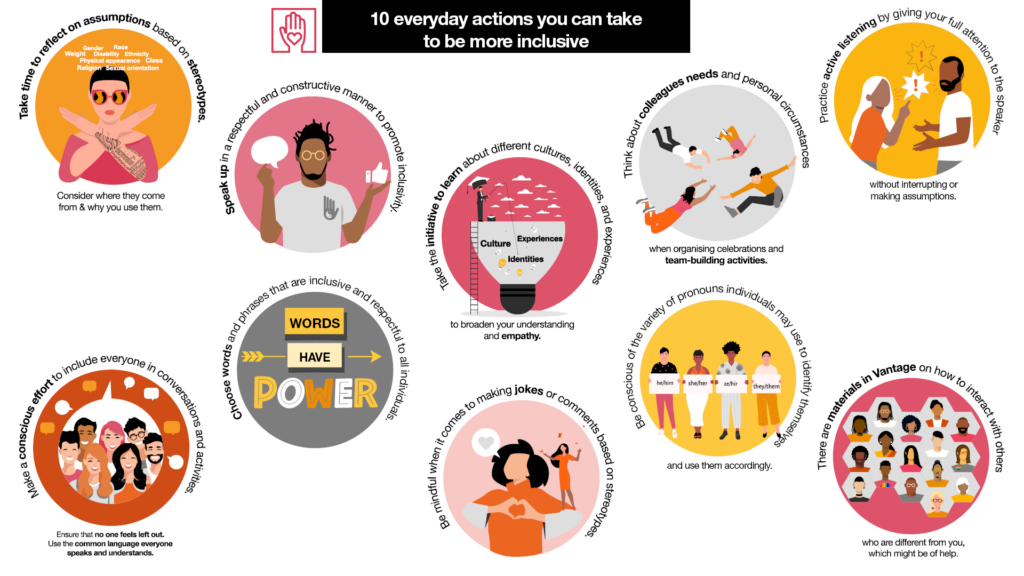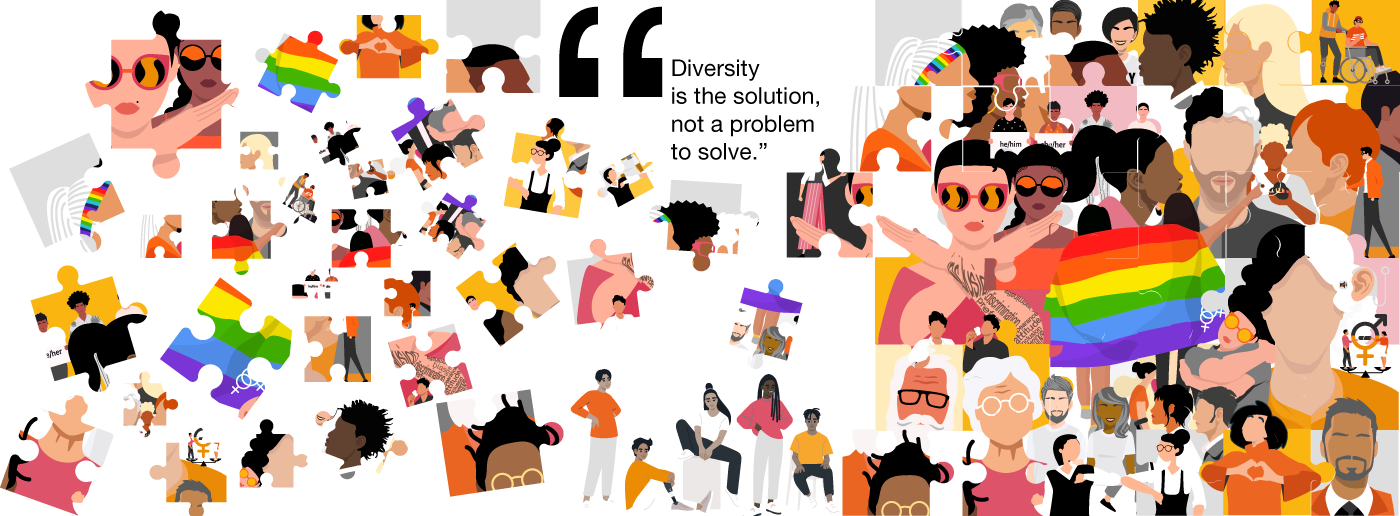In this blog, we talk about ‘the inclusion habit’. More to the point, why inclusion matters, why it has value and how managers and teams can build inclusive mindsets into their daily work culture beyond formal training.
‘Tell me and I forget, teach me and I may remember, involve me and I learn.’* This quote comes from Xun Kuang, a Chinese Confucian philosopher that lived from 312-230 BC, in the book Xunzi. It perfectly encapsulates the philosophy behind making inclusion a daily personal habit.
Beyond all the policies that governments and companies can put in place—and these have their place as well—real inclusion occurs when the understanding of the value, and then the responsibility, is given to the individual to embed in small actions in their daily lives and work routines.
Why inclusion?
Well first, why not? But we suppose that is an opinion. So, let’s try it another way.
Finishing a very challenging puzzle is a tremendously satisfying feeling. The tougher the puzzle, the better the feeling on completion. Part of that dopamine effect comes from watching the realisation of hours and hours come together in a fantastic picture—a ship on the sea perhaps, or a city you have just visited, the garden of Eden or a basket of puppy dogs playing with kittens.
According to the infamous Myers-Briggs personality test, puzzle people tend to be organised, observant and detail-orientated, and super puzzle people tend to rely on logic and facts, are great at finding patterns and—here is the best part—love putting small details together to make a bigger picture. So, we will do our best to rely on logic and facts. Because the bigger picture is the end goal.
Around this time of year, our blog team normally dedicates a blog to LGBTQI+ issues, and we do so because it is close to when Pride occurs in Luxembourg (and elsewhere) across the summer. This blog does have a Shine focus—Shine being our PwC inclusive business network focused on the LGBTQI+ community and its allies. You can read some of the blogs from our more recent years in the list of links we have added to the bottom of this blog.
But we’ve come a long way, baby. Our firm is working very hard to expand that oh-so important notion that everyone who works for us should be able to bring their true self to work every day, at a local, EMEA (Europe, Middle East, and Africa), and global level.
This means visible and invisible physical and mental obstacles should be understood and accounted for, cultural and socio-economic differences should be considered, and biases should be recognised and overcome. The goal is to lead to a culture of true equity for all, including the people we are supporting or working together with at Shine. And ourselves, of course.
So, let’s get back to our puzzle. To make a picture of a garden, you need different shapes of puzzle pieces, assorted colours to develop the picture, and often the pieces themselves contain multiple colours. That’s diversity.
If you miss even one piece—just one—you can’t complete the puzzle. And you can’t just make sure you have the red and blue ones in place and ignore the others. It doesn’t work. This is what inclusion is all about.
Some people will have not only different shapes, but also different colours, ages, cultural backgrounds and educations, and some will have a disability that is invisible to you like sight or hearing, or a deep sadness from being an immigrant, or a displaced person, from a country where they were persecuted.
There are people of different abilities, genders, who come from various places—some of privilege, many of non. Taking care of each one of those pieces, giving them their place and smoothing out your completed garden is an amazing accomplishment, and it has immense value in the corporate world. But don’t take our word for it.
The Overwhelming Case for Inclusion & Diversity in the Workplace**
Of the multiple studies, research papers and articles there are out there arguing for inclusion and diversity in the workplace, we like this one by Harvard educated Mukul Chopra, “The Overwhelming Case for Inclusion & Diversity in the Workplace”. In this professionally researched and well-received paper, Mukul argues that inclusion and diversity have been proven to bring better financial results.
“In fact, a Boston Consulting Group (BCG) study, which studied 1,700 companies in eight countries, found that diverse leadership teams result in better innovation and improved financial performance. Specifically, companies that reported above-average diversity on their management teams also reported innovation revenue that was 19 percentage points higher than that of companies with below-average leadership diversity.”
His research also demonstrates that there is, “strong evidence that teams with a diverse background and random member selection are likely to be more successful and have better performance. They do this by being more likely to innovate, be more agile, and anticipate shifts in consumer needs—helping their companies to gain a competitive edge.”
This isn’t fresh news. As far back as 2018, PwC UK published a report entitled, “Diversity is the solution, not a problem to solve”.
What is key at this point is the embedding. This brings us back to the inclusion habit and our puzzle. If people learn and then start to build small actions into their daily routines, it’s as if the puzzle starts putting itself together.
What is the inclusion habit?
The Inclusion Habit is a programme designed to help individuals develop more inclusive behaviours through a series of habit-building phases. Developed by Amanda J. Felkey, PhD., it focuses on changing behaviours and habits to make individuals more proactive in their inclusive actions. It includes phases such as understanding biases, dispersing negativity associated with unconscious biases, practicing deliberate thinking, reprogramming incorrect intuitions, and becoming more empathetic.
You can read more about it in the journal “Profiles in Diversity Journal, Leadership Defined” in a paper referenced above written by Dr. Felkey. It is an “evidence-based solution that transfers inclusion work to the individual, and focuses on changing behaviors and habits. It uses small daily activities designed to mitigate biases and microaggressions, while creating new habits of understanding, empathy, and inclusion.”
While Dr. Felkey’s research doesn’t go against programmes and policies, it recognises their limits and explains how companies, where people spend a large percentage of their lives, are the perfect place to embed this philosophy.
“Enhancing inclusive behaviour needs to be propelled by companies, but start with individuals. The workplace is the best place to enhance inclusive behaviour. Indeed, it is likely the only place to make strides toward a more inclusive society. In all other facets of our lives, we surround ourselves with people who are like us (…). For most of us, work is the only place that is truly diverse, making it the corporation’s responsibility to arm employees with the resources necessary to face diversity, embrace diversity, understand diversity, and be inclusive of diversity.”
Honestly, we love this statement because it also shows that diversity is the springboard to inclusion. And there is a clear six phase roadmap to help companies start to work on this puzzle.
Building an inclusion habit – six phases as per Amanda J Felkey, PhD
Phase 1: Why inclusion matters.
Click here to expand or collapse
For an individual to engage in creating a new habit, she or he need to believe the new habit will be beneficial. This phase will create an accurate understanding of the advantages of inclusion, as well as the current status of inclusion and diversity in today’s workforce. The tasks will ask individuals to personalise and operationalise this information, so they can enhance their acknowledgement of advantage and grow positive perceptions of diversity and inclusion. The goal is for individuals to believe that inclusion is an issue worth being diligently addressed by new habit formation.
Phase 2: Understand and recognise biases.
Click here to expand or collapse
Before individuals can start to create new habits that will override their biases, they need to know what biases they hold, what parts of their intuition are incorrect, and when those biases creep into their decisions and actions. This phase will equip individuals with diagnostic labels for biases and behaviours that are readily accessible, making biases easier to identify, recognise, understand, and anticipate. It will also promote self-awareness as individuals identify, and reflect on the origins of, their biases.
Phase 3: Disperse the negativity.
Click here to expand or collapse
Biases and discrimination are surrounded by negativity that propagates self-defensive reactions. For example, being or acting racist is so fraught with negative emotion that when we have a racially biased thought, we immediately shut down and devote attention to explaining why and how we aren’t racist, rather than critically examining that bias or systematic error in our thinking.
Since, in large part, our biases are artifacts of the architecture of our brain and the social systems into which we were born, we can work to mitigate much of the negativity accompanying these thought errors. To minimise the defensive avoidance responses, this phase will focus on normalising biases and creating self-affirming behaviours, so biases are no longer denied, but rather, examined and challenged.
Phase 4: Practice thinking slow.
Click here to expand or collapse
Our slow thinking is deliberate, informed, and contentious—it is responsible for most of our decisions and actions. When conditions allow, our slow thinking will filter, modify, and maybe even censor our fast thinking or intuition, where biases reside. Slow thinking is what keeps our actions in line with our intentions and values. This phase will teach individuals to recognise situations in which they are more likely to make decisions based on their biases and help them practice thinking more deliberately in those circumstances.
Phase 5: Reprogramme fast thinking.
Click here to expand or collapse
Relying on our fast thinking is inescapable. In fact, it is indispensable as it is what allows you to perform at a high level. Since fast thinking is essential, individuals need to diligently examine their intuitions to ensure that they are providing correct, unbiased information. This phase will help individuals create new intuitions that will override old biases.
Since our implicit attitudes are malleable, the goals of this phase are to challenge what we know about people different from us, change our intuition about other groups of people, and create intuitions that focus on individual attributes rather than group stereotypes. With new correct intuition, individuals will act more inclusively, even when they are thinking fast.
Phase 6: Enhance empathy.
Click here to expand or collapse
Practicing empathy is important to being inclusive for two reasons: First, enhancing our ability to truly understand others will allow us to build more correct intuition and fast thinking in the future, ensuring that we don’t create more biases; and second, empathy, including listening well and picking up on unspoken cues, will allow us to be inclusive of the diversity we can’t see, the diversity people don’t explicitly share. This phase will encourage individuals to expand their comfort zone to interact authentically with people different from themselves, communicate with a goal of understanding, and cultivate a curiosity about others.
What role can companies play?
We have already discussed why companies are the perfect vehicles for inclusion. On top of this, companies that lead in diversity and inclusion understand that this helps to build a stronger corporate culture, and that a diverse workforce makes them more innovative and competitive. As a result, they become more attractive as they try to draw from a more and more diverse talent pool.
Our own firm, for example, has a strong and longstanding commitment to Diversity, Equity, and Inclusion (DEI) as core values. We have implemented numerous initiatives and programmes—both at a local, EMEA and global level—to foster a more diverse, equitable, and inclusive workplace. This includes employee resource groups, such as Shine, inclusive leadership training, pay equity reviews, and partnerships with organisations supporting underrepresented communities.
Companies still need programmes and policies to guide people to their inclusion habit. For example, at PwC, we have developed an Inclusive Mindset training for which people get a badge on completion. There are many companies doing this, but it is important to explore this further and commit to having as many members of the DEI team, leadership and as many people in the company complete the training as possible. In fact, the best action would be to make this training mandatory for everyone in a company. In this way, people become aware and start to understand and recognise their own biases.
Another priority is to increase the number of allies. Allies are people in our daily lives and in our companies with a recognisable characteristic- they are willing to take action or support other people. Their main power is that, behind their support, they are helping to remove barriers that they or others face that impede another person (or persons) the ability to showcase his/her/their full potential in the workplace.
Cultivating an inclusive workplace

Click to enlarge.
Feel free to download this image and print it on A4. We hope it helps serves as a daily reminder.
How many allies does a company need?
In our opinion, there can never be too many allies. To help activate allyship, it is important to discover and identify what some of their motivations and fears are. In a corporate setting, do they fear professional retribution or even career damage? Are people able to speak up?
Companies can also provide clear guides and self-learning resources. People in the workforce today are motivated by purpose as much as by anything else. They want to join a company that is inclusive, and most people can be taught how to embrace small steps and actions. As we know, taking small actionable steps can create big ripples of change.
Allies can be powerful game changers and we can learn from them. They are role models. In fact, their actions can be carefully mapped out across different levels of the organisation to act as catalysts for a more global change of behaviour. What are some of the actions people can take to make their work environment more inclusive? As we mentioned, they can educate themselves and this also means you, dear reader. Don’t close your mind to change. Don’t assume you know the answers. Be curious. Learn about yourself and learn about others. Discover your biases. This is a path that never ends. There is always room for self-improvement.
Be aware of your surroundings. A good ally and/or leader pays attention and acts with humility. Seek out feedback, and don’t be afraid to hear it. The way you respond to feedback will reflect how honest people will be with you in the future. Listen to other perspectives and give them visibility.
It is also important to be your own true self at work. Because doing so, not being afraid to be who you are, is contagious. It invites others to be authentic as well.
Most of all, be inclusive yourself, especially if you are a leader because you are the beacon that shines the light for safe passage. Be accepting of others. It’s not always easy, we know. We all judge, whether we want to admit it or not, and we all have biases and ideas based on stereotypes. But a good inclusive leader is one who is open and accepting. And most likely, the one who has a team that will follow her/him anywhere because they have earned respect and trust.
Notes:
*The quote mentioned in our blog, often wrong attributed to Benjamin Franklin, comes from the below original translated passage: “Not having heard something is not as good as having heard it; having heard it is not as good as having seen it; having seen it is not as good as knowing it; knowing it is not as good as putting it into practice. Xun Kuang, Chinese Confucian philosopher that lived from 312-230 BC. The Teachings of the Ru
**The Overwhelming Case for Inclusion & Diversity in the Workplace. Both the title and the summarised points come from a LinkedIn article, by Mukul Chopra, Technology Innovation|CIO|Adjunct Faculty|Keynotes|Change Management|Digital Transformation, written in 2021.
What we think

Marc Schernberg de Plata Acevedo, Partner and DEI Leader at PwC Luxembourg
I strongly believe that diversity is a treasure we should cherish, enriching our perspectives and fuelling innovation. For companies, having equity and inclusion policies is crucial as they ensure fair opportunities and representation for all employees. These policies foster a positive workplace culture, enhance creativity, and improve decision-making. By valuing diverse voices, companies can better understand and serve their customers, driving growth and maintaining a competitive edge in an increasingly globalised market. To ensure success, it is however key that this mindset becomes part of any company’s culture, starting from the top, risking otherwise that from a hero you become a zero.
Inclusion isn’t built on policies. It’s built on daily acts of recognition. See the person, not the label. Value their work, not their category. As leaders, we set the tone. Not with speeches, but with actions. Listen more. Assume less. Learn always. True inclusion is a habit, not a checklist.

Armin Prljaca, Strategy Manager, Strategy& Part of PwC Network and Shine Leader at PwC Luxembourg

